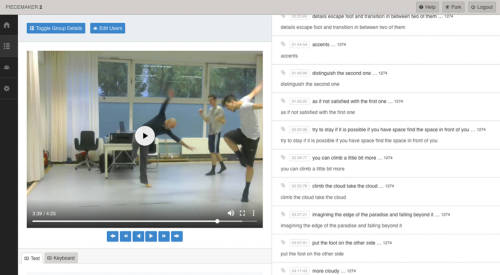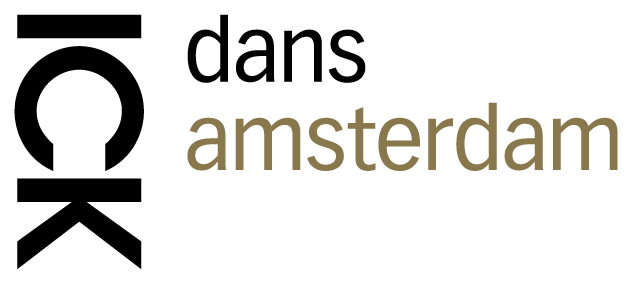An interview with dance researcher Suzan Tunca by Desiree Hoving
How beautiful it would be if choreographies could be danced again even after a hundred years. ICK is, therefore, working on a way to ‘archive’ contemporary dance. Not just in order to pass it on to future generations, but also to build bridges with the world outside dance.
When you wish to write music, you describe what must be played on a staff as best as possible. If you give that to any musician on any kind of instrument anywhere in the world, he or she will play exactly the music that’s on the paper. That’s because there are international agreements in place for putting notes on paper.
There is such an international notation system for dance, too, one in which a dance notator writes down all the movements in time and space on a kind of staff. Instead of notes, the notator uses symbols to represent steps, positions and transitions between movements. That way it is clear when a dancer must move his left arm to the right and his right foot forward. The system is called Labanotation in English and it was devised in 1928 by Rudolf Laban, a pioneer of modern dance.“But it doesn’t suffice for all forms of contemporary dance”, Suzan Tunca explains.
She used to be a dancer with ICK and today she leads the research into the notation, documentation and transfer of dance. “It isn’t just about the body that moves from one position to the next. A choreography is much more than that. It’s about the interplay between body and mind. What you feel, what you’re thinking about, what music you hear, who you’re dancing with and what kind of lighting is present in the space, these are all important factors. She gives an example: “If, as a dancer, you have an image in your head of a sea shell opening, then you execute that step sideways quite differently than if you took that step for the sake of that step.”
But how do you notate dance if you wish to record more than just the steps? And what do you do if the steps are of no importance? ICK has researched this for more than a decade. In 2007 the dance company published the book (Capturing Intention), which translates as recording the intention. The title is written in parentheses on purpose, because dance cannot really be captured. “It’s immaterial and exists only in the moment. Whereas art that’s material, like a photograph of a painting, can be captured more easily,” Tunca says.
The book deals with the role of intention in the dance itself, but also in other art forms, science and philosophy. “We wish to build a bridge to the society outside the dance. Dance can create a specific form of consciousness and stimulate reflection and discourse,” Tunca explains. “Together with architects, musicians, psychologists and philosophers we want to investigate creative processes further, because intellect, instinct, emotion and physical intuition play a part, not just in dance, but beyond it as well.”
Since 2015 the focus of the dance research has shifted from ‘notation’ to ’annotation’. With notation it’s all about finding notation systems, which often involve symbols the whole world knows, as with music notation. Furthermore, notation is intended to describe the choreography as meticulously as possible. Annotation, by contrast, operates without symbols and uses language as a complement to images. The purpose is to add more depth to a recorded choreography.
Annotation appears to be more suitable for contemporary dance, but it’s still in its infancy. ICK is currently investigating an instrument for annotation that was developed by Motionbank, in which language is used in combination with video images in order to document creative processes in the dance. This puts a greater emphasis on the explicit spoken language that occurs alongside the implicit physical language of the dance during the creation of new choreographies.

In her annotation research Tunca employs the ABCdaire, a kind of glossary of 176 alphabetically arranged terms that derive from the choreographies of Emio Greco and Pieter C. Scholten. “Contemporary dance has almost no common vocabulary, which is something that Classical Ballet does have. Therefore we wish to give movements deriving from physical origins a verbal dimension. The verbal dimension can be regarded as a kind of basic ingredient of the dance which will persist over time,” Tunca says. She offers an example straightaway:
She moves her right hand up slowly and when her arm is stretched, she drops the hand quickly. “For instance, consider the term ‘echo’. That refers to what takes place inside the body after a movement. You don’t see it, but you can feel it all the same.” Other examples of terms included in the ABCdaire are breathing, jumping, expanding and reducing. Those terms are being used in the dance method Double Skin/Double Mind, once again developed by Emio Greco and Pieter C. Scholten. This method is implemented both in dance and outside of it in preparation of creative processes.

Another element of the ABCdaire are the pre-choreographic elements. This refers to a phase within the creative process in which all kinds of movements emerge before they begin to constitute a choreography. Tunca shows a video: It’s called Around Ball. We see various dancers who draw inspiration from the notion of a ball; now because they’re holding one in their hands, now because they themselves appear to imitate the movement of a ball. “The dancers are investigating here in the studio how they can translate and embody a movement concept like Around Ball via motion experiments,” Tunca explains. Twenty of those concepts have now been recorded, but the aim is to expand the movement vocabulary even further. This isn’t just intended to describe the origins of existing choreographies, but also to be used in the conceptualisation of new movements.
The audience doesn’t have to wait before they can see another performance by ICK. There are video registrations, available on request, of performances to watch, there are reviews for perusal and you can browse through the extensive photographic record of the repertoire of choreographers Emio Greco and Pieter C. Scholten. This can be done in the multimedia library of ICK that offers free admission to anyone who wants to learn more about dance.
Photo 1: Suzan Tunca by Alwin Poiana
Photo 2: Screenshot Annotation system by Motionbank
Photo 3: Arad Inbar in research project HARMONIC DISSONANCE– SYNCHRON(ICIT)Y by Nikki Schuurmans


0 Comments